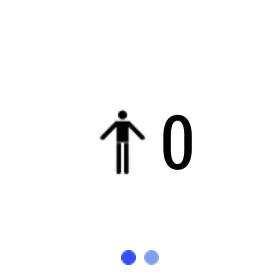A basic sample showing how to use the Gravity sensor on the wearable device by counting how many jumping jacks you have performed.
SensorEventListener offers you methods used for receiving notifications from the SensorManager when sensor values have changed.
This example counts how many times Jumping Jacks are performed by detecting the value of the Gravity sensor by the following code:
@Override
public void onSensorChanged(SensorEvent event) {
detectJump(event.values[0], event.timestamp);
}
private void detectJump(float xValue, long timestamp) {
if ((Math.abs(xValue) > GRAVITY_THRESHOLD)) {
if(timestamp - mLastTime < TIME_THRESHOLD_NS && mUp != (xValue > 0)) {
onJumpDetected(!mUp);
}
mUp = xValue > 0;
mLastTime = timestamp;
}
}The detectJump method above assumes that when a person is wearing the watch, the x-component of gravity as measured by the Gravity Sensor is +9.8 when the hand is downward and -9.8 when the hand is upward (signs are reversed if the watch is worn on the right hand). Since the upward or downward may not be completely accurate, we leave some room and instead of 9.8, we use GRAVITY_THRESHOLD (7.0f). We also consider the up <-> down movement successful if it takes less than TIME_THRESHOLD_NS (2000000000 nanoseconds).
- Android SDK 28
- Android Build Tools v29.0.2
- Android Support Repository
This sample uses the Gradle build system. To build this project, use the "gradlew build" command or use "Import Project" in Android Studio.
- Google+ Community: https://plus.google.com/communities/105153134372062985968
- Stack Overflow: http://stackoverflow.com/questions/tagged/android
If you've found an error in this sample, please file an issue: https://github.com/googlesamples/android-JumpingJack
Patches are encouraged, and may be submitted by forking this project and submitting a pull request through GitHub. Please see CONTRIBUTING.md for more details.
